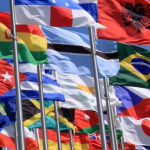
Simply speaking, a flag is just a piece of material flown from a mast or pole, yet each flag design is bursting with history…
The use of flags can date back to around 1000 BC, when the Egyptians used to use primitive versions of flags. Since then, flags have grown to become a symbol, often representing geographical regions, countries and nations. The history of flags is vast and expansive, so much so that it has it’s own scientific study, known as vexillology.
As well as representing countries, flags can also be used at sea to signal each other and to harbours, used as a symbol, sending a signal, communication or identification. Explorers use flags to show new lands conquered - ie the moon and the top of Mount Everest.
No matter what a flag is used for, each has their own history; here’s a quick run down of historical country flags and other popular and famous flag designs, including those which represent religions and cultures.
List of the Oldest Country Flags
Flags have been around for thousands of years, and some of the world’s country flags have managed to withstand the test of time, representing their country for hundreds of years. Here’s a list of some of the oldest country flags in the world.
Scotland Saltire 832 AD - The flag was allegedly first flown at a battle fought in East Lothian is the dark ages. The white cross represents Saint Andrew, who was supposedly crucified on a similar cross.
Austria 1230 AD - The Austrian flag was adopted by Friedrich II, the last Babenberg as Duke of Austria in the 13th century. The design contains three equal horizontal bands, two red with one white in the centre.
Latvia 1280 AD - First used by the Latvian military in 1279, it was documented as a simple design of carmine red cut through with a horizontal white stripe - identical to the design used today.
Denmark 1307 AD (or earlier) - The flag of Denmark is the oldest continually used national flag, according to the Guinness World Records. According to legend, the flag was first flown in the Battle of Lyndanisse in 1219, but the first use on factual record was noted nearly 100 years later.
Albania 1443 AD - The first sighting of Albania’s flag happened when Skanderbeg, the national hero of Albania, raised his flag in defiance of the Turks who ruled the country. The flag consists of a two headed black eagle backed onto a red field.
Most Recognisable World Flags
Around the world, there are certain world flags that are instantly recognisable due to their iconic designs and the countries they represent.
United States of America - 50 stars and 13 horizontal stripes to represent the 13 original colonies: Connecticut, Delaware, Georgia, Maryland, Massachusetts, New Hampshire, New Jersey, New York, North Carolina, Pennsylvania, Rhode Island, South Carolina and Virginia.
United Kingdom - The Union Jack, or Union Flag, represents each of the countries under the Sovereign nation. The St George’s Cross of England, The St Andrew’s Saltire of Scotland and the St Patrick’s Cross of Northern Ireland. One of the oldest flags, adopted in 1801. Famous around the world for being incorporated into flags of former British colonies, such as Australia and New Zealand.
Australia - The Australian flag is similar to that of New Zealand, containing a Union Jack in the top left, a royal blue base, and a constellation of stars. The Southern Cross constellation can be seen in all of Australia’s territories, and is joined by two other stars to represent each state.
Canada - The Canadian flag consists of three vertical stripes, two red and one white. The central white stripe has an 11-point maple leaf emblem in the centre. The flag was adopted in 1964 and was inspired by the maple leaf design of the flag of the Royal Military College of Canada.
New Zealand - A dark blue base with a British Union Jack in the left hand corner. The Union Jack represents the country’s British commonwealth heritage, with the constellation of the Southern Cross to represent New Zealand’s geographical position to the rest of the world.
Most Popular National Flag Colours
Red: 155
White: 144
Green: 97
Least Known Flags
We’ve mentioned some of the most recognisable flags, but what about the ones that nobody recognises? Here’s the top five flags people are least likely to recognise.
Sao Tome and Principe
Other Well Known Flags
As well as world flags to represent countries, states and nations, flags can also represent people, groups and religions. Here’s a list of popular and recognizable flags that don’t represent a country.
LGBT Flags - Each year, gay pride events are held around the world, making this group of flags recognizable. The rainbow flag is the most famous, designed by Gilbert Baker in 1978. Other flags include the bear flag, the pansexual flag and the asexual flag.
Sporting Flags - Throughout history, flags have been used in sporting events. From the checkered racing flag to start and finish races to the flag used by referees at football matches, there are loads of important sporting flags available.
Religious flags - Flags for religions have been used since the early 19th century, used across the world in places of worship. From Christianity to Buddhism and Sikhism, the history of each flag design is ultimately unique.















